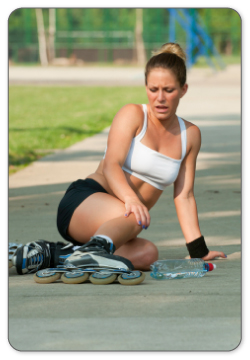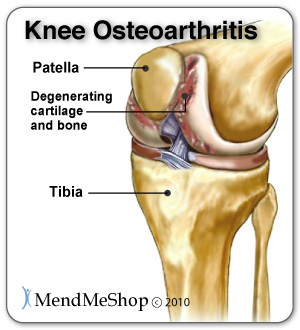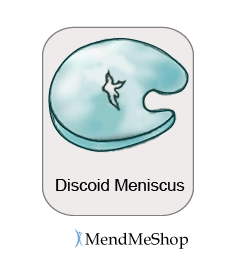The knee is one of the most complex and largest joints in the body. Not only can you flex and extend your knee, you also have the ability to rotate the knee horizontally. The knee provides both strength and flexibility during leg movements, while being loose enough to allow the freedom for quick movements and changes in directions. This strength and flexibility in the knee also makes it more risk for have an injury.
Any one can suffer from a meniscus injury but those that are at greater risk are:
Although knee injuries are more common in women than men, men experience more meniscus injuries and tears (approximately 2.5 males: 1 female). This is believed to be due to men's participation in more aggressive sports and manual activities. For tears due to activity, meniscal injuries in men occur most often between the ages of 31 to 40; for females meniscal tears usually occur between 11 and 20 years.
The most common causes of meniscus injuries in young people is acute trauma to the knee whereas degeneration of the knee joint tissue is the most common cause in seniors. In either case, a piece of the meniscus can loosen or tear and move around in your joint interfering with your normal knee movement and function. A person with a discoid meniscus is also at greater risk of experiencing a meniscus tear or damage.

The most common location for a meniscus tear is in the back of the knee and on the inner side of the knee. In medical terms this means that of the two meniscus in the knee (lateral vs medial), the medial meniscus is more likely to tear. Further to this, the tear is more likely to occur near the posterior horn - which is located at the back of the knee.1

Forceful blows to the knee occur most frequently during activities such as rugby, football, baseball, soccer, basketball or racquet sports when you twist your knee, or slow down too quickly. A meniscus injury can occur during a hit if the knee is forcefully rotated while the foot is firmly planted and bearing weight. A meniscus tear can also occur from hyperflexion or hyperextension of your knee (flexion or extension beyond your knee's normal range of motion). A sudden fall on the knee without protection. Hyperflexion or hyperextension can occur during a car accident, while participating in sports or exercising, or during other low-impact activities if the knee is unstable.
Regarding the medial meniscus, young athletes are more likely to suffer a medial meniscus tear combined with a medial collateral ligament (MCL) injury. When the medial meniscus tissue is stressed and pulled, a 'bucket-handle' tear might happen. The most common location for injury is to the posterior horn of the medial meniscus, and longitudinal tears are the most common type of tear that happens.
Regarding the lateral meniscus, young athletes are more likely to suffer a lateral meniscus tear along with an anterior cruciate ligament (ACL) injury. The center or middle body of the lateral meniscus stretches outward when force is applied because it's anchored at the 2 ends (anterior and posterior) while the middle floats freely in the joint. This is why it's more likely for the lateral meniscus to tear in half and possibly rip so severely that it hangs by one thin fiber.
These types of tears generally affect athletes or those under 40 years of age. A medial meniscus tear will frequently occur along with other injuries such as an MCL and/or ACL tear. A combined knee injury is usually seen in contact sports when an athlete gets hit on the outside of a bent knee. A lateral meniscus tear will result more often from a knee that is bent (flexed) excessively and experiences full weight bearing, while the thighbone is turning outward; seen in sports such as skiing.

In younger people, the meniscus is very flexible and pliable like a new rubber tire. As we age the meniscal tissue weakens and becomes less flexible, more brittle and develops small cracks much like those seen in an old car tire (fibrocartilage). Once a meniscus is degenerated significantly, the weak meniscus can become injured with only slight trauma, such as getting down into a squat. Sometimes there is no one event that can be blamed for the cause of a meniscus tear due to degeneration. Unfortunately, the blood supply to the menisci decreases by 20% by the age of 40 and the body's ability to heal itself becomes reduced. As a result, it is more difficult to heal a tear caused by deterioration than an acute trauma that occurs earlier in life. Approximately 60% of people over 65 years of age will experience some form of degenerative meniscus tear. (source Medscape.com - web resource for physicians and other health professionals.)
Normal wear and tear on the knee tissue can also lead to osteoarthritis. If osteoarthritis sets in, the body releases a chemical substances in the joint cavity which further breakdown and weaken soft tissue, including the meniscus.
A discoid meniscus is known as an abnormally shaped meniscus in the knee. The misshapen meniscus occurs during formation - in the fetal stage of growth. If you have a discoid meniscus, you will find that the menisci are flat and disc shaped rather than crescent shaped wedges. Due to its shape, a discoid meniscus is at a greater risk of tearing than a regular shaped meniscus.

A discoid meniscus generally occurs in the lateral meniscus (1.5-3% of the general population) but can appear in the medial meniscus (0.1-0.3%). There is a greater frequency of discoid menisci reported in people of Asiatic descent with approximately 17% lateral discoid menisci reported. A discoid meniscus is generally found in children less than 11 years of age but the meniscus will often change to a c-shape with maturity, so children will usually grow out of their symptoms.
If there is a tear present in a discoid meniscus, one or more of the following symptoms may be experienced:
A discoid meniscus has also been referred to as "snapping knee syndrome". Some people may go through their entire lives with a misshapen meniscus and ever experience any problems.

Click HERE to Go To Our Online Store We take all major credit cards and Paypal.
If you have questions, call our office at 1-866-237-9608 (toll free continental US).
We are currently offering FREE SHIPPING and a 60 day trial period on all our Wraps.
Product Advisors are available 9:00 am to 5:00 pm Eastern Standard Time Monday to Friday.
Product specialists are available 9:00 am to 5:00 pm Eastern Standard Time Monday to Friday.
If any question or concern arises, call us or simply send us an email at any time (we check our emails constantly all throughout the day and night.. even on holidays!). We will respond as soon as possible.
1."Posterior Horn Medial Meniscus Tears - Howard J. Luks, MD". 2019. Howard J. Luks, MD. Accessed July 24 2019. website.
I want to learn more about Post-Surgery Recovery
I want to learn all about Types, Patterns, Shapes & Severity of Meniscus Tears
I want to learn more about TShellz Wrap® Circulatory Boost
I want to learn more about Ice & Heat: Which Is Better For Treatment?
I want to learn more about Meniscus Treatments
I want to learn more about different types of Meniscus Surgery
During your recovery, you will probably have to modify and/or eliminate any activities that cause pain or discomfort at the location of your soft tissue injury until the pain and inflammation settle. The more diligent you are with your treatment and rehabilitation, the faster you will see successful results!
Please be aware that this information is neither intended nor implied to be a substitute for professional medical advice. CALL YOUR HEALTHCARE PROVIDER IMMEDIATELY IF YOU THINK YOU MAY HAVE A MEDICAL EMERGENCY. Always seek the advice of your physician or other qualified health provider before using any of our outstanding products to make sure they are right for you and your condition or if you have any questions regarding a medical condition. Always see your doctor for a proper diagnosis as there are often many injuries and conditions (some very serious) that could be the cause of your pain.
© 2025 In.Genu Design Group, Inc. Contact Us